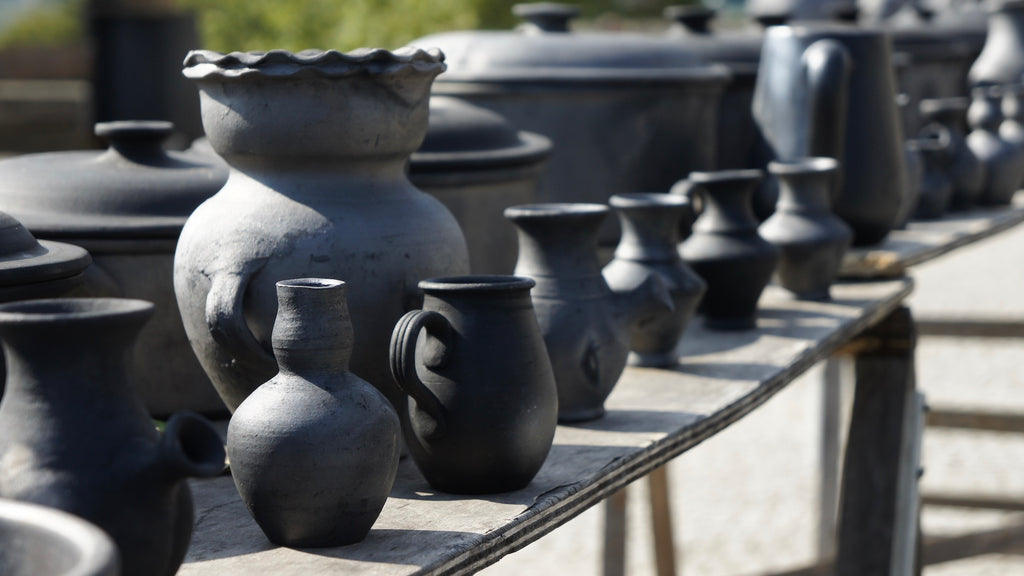

The black pottery of Bisalhães, protected by UNESCO but disappearing.
Perhaps you have never heard of the village of Bisalhães. This small mountain village located in the municipality of Vila Real has a specificity: its artisans produce black clay, called "black pottery of Bisalhães". In November 2016, UNESCO declared this art intangible cultural heritage. However, this tradition remains on the way to extinction. Of the artisans who knew the secrets of this art, only five remain.

★ In search of the black pottery of Bisalhães

Once in Vila Real, the best thing to do is to go to Avenida da Noruega. There you can see the 4 or 5 permanent stands set up by the municipality and meet the few potters who present their work there. Then ask them to show you the way to Bisalhães, which is about 10 km away.

Bisalhães is a small and unexpected village as it still exists in Portugal. To tell the truth, the term of village is improper, it is appropriate to speak about a hamlet gathering some houses. No inhabitant in sight, a few stray dogs, a single twisted street, a few paths and at the bend of one of them, a large black trace on the ground and some stones testify to the existence of a "soenga", a typical clay oven of the Bisalhães process.

* In August 2021, in the middle of the tourist season, we returned to Vila Real and Bisalhães. All the potters' stands were closed except for the one of the Ramalho family. Jorge recognized us and welcomed us to announce the death of his father whom we had met 2 years before. Jorge has taken over and, with the help of the City Council, continues to produce black pottery, but it seems that he is the only one and that the black pottery of Bisalhães is definitely threatened with extinction.
★ The manufacturing process of black pottery
The preparation of the clay
The clay is crushed in a stone basin by means of a wooden hammer in order to make it as fine as possible. The clay is then sifted, manually, in order to extract the impurities and the pieces which would harm the solidity of the realized pieces. It is finally moistened and kneaded to form a large ball ready to be turned.

The manufacture of potteries.
The clay is shaped on a slow wheel. All pieces are turned by hand, so no two are alike: dimensions and shapes are completely unique. After drying, the resulting piece is traditionally polished with pebbles and decorated with a simple wooden stick.


The firing

Crédit photo : Who trips

Crédit photo : Who trips

★ A disappearing heritage
Over the decades, the local community has not taken charge of the transmission of knowledge to new generations. The arduous work necessary to the manufacturing process of the black earthenware of Bisalhães (transport, collection of the raw material, preparation of the pieces, firing process and sale), the traditional division of tasks, with the intervention of women, the little social valorization of this art, leads the young generations, to emigrate, in search of new ways of life.

★ Sezinando Ramalho
In 2018, we met Sezinando Ramalho who explained to us that he got his technique from his father. He was one of the last 5 potters to master the art of black pottery from Bisalhães and was working hard to defend its history, heritage and technique. He tried to renew the style of the pieces he produced without making any concession to his own technique. Thus, he had, in collaboration with a young designer, conceived abats jours which joined one of the fashionable restaurants of Lisbon. He also agreed to adapt the dimensions of some of these pieces at the request of a Japanese importer who sold them at a high price.

In 2021, it is with a sad heart that we learned of his death. With him disappears another face of Bisalhães, who dedicated so much of his life, his hands and his love to this ancestral art.
★ Hope for the black pottery of Bisalhães ?
Hope comes from Jorge Ramalho, Sezinando's son, a promising potter who, with perseverance, continues to give life to the Pottery of Bisalhães. It is his pottery that you can find on sale on the website Luisa Paixâo





Comments
Lovely story! Thank you for sharing this knowledge


April 25, 1974. The carnation revolution hour by hour
April 25, 1974 marks the beginning of the Carnation Revolution which led to the downfall of the authoritarian regime and the establishment of a new era of democracy. Discover the events of this day...

